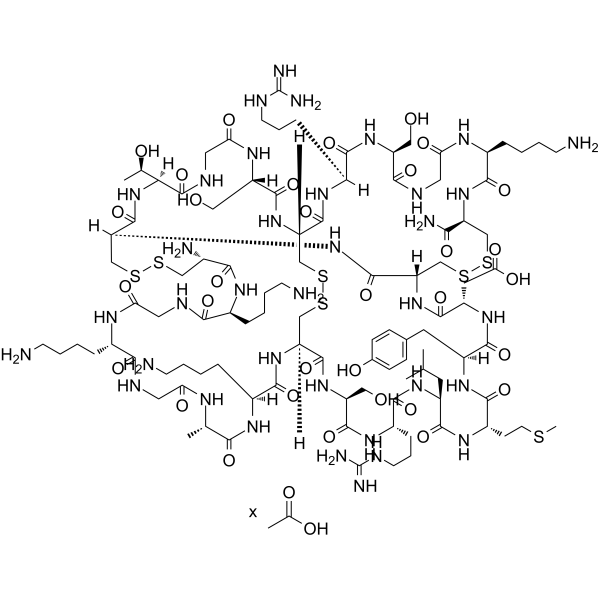
Ziconotide Acetate
CAS No. 914454-03-8
Ziconotide Acetate ( Prialt )
Catalog No. M29585 CAS No. 914454-03-8
Ziconotide is an analgesic agent and has been used to treat neuropathic and non-neuropathic pain. Ziconotide acts by binding to N-type calcium channels situated on the terminal part of primary afferent neurons of the nociceptive pathway therefore reducing synaptic transmission with potent antinociceptive effects.
Purity : >98% (HPLC)
 COA
COA
 Datasheet
Datasheet
 HNMR
HNMR
 HPLC
HPLC
 MSDS
MSDS
 Handing Instructions
Handing Instructions
| Size | Price / USD | Stock | Quantity |
| 5MG | 335 | Get Quote |


|
| 10MG | 484 | Get Quote |


|
| 25MG | 771 | Get Quote |


|
| 100MG | Get Quote | Get Quote |


|
| 200MG | Get Quote | Get Quote |


|
| 500MG | Get Quote | Get Quote |


|
| 1G | Get Quote | Get Quote |


|
Biological Information
-
Product NameZiconotide Acetate
-
NoteResearch use only, not for human use.
-
Brief DescriptionZiconotide is an analgesic agent and has been used to treat neuropathic and non-neuropathic pain. Ziconotide acts by binding to N-type calcium channels situated on the terminal part of primary afferent neurons of the nociceptive pathway therefore reducing synaptic transmission with potent antinociceptive effects.
-
DescriptionZiconotide is an analgesic agent and has been used to treat neuropathic and non-neuropathic pain. Ziconotide acts by binding to N-type calcium channels situated on the terminal part of primary afferent neurons of the nociceptive pathway therefore reducing synaptic transmission with potent antinociceptive effects.
-
In VitroMost native cells express a variety of different calcium channels and as a result, Ziconotide acetate only partially reduces high-voltage-activated calcium currents in differentiated human neuroblastoma IMR32 cells, rat superior cervical ganglion neurons, and rat hippocampal neurons. Ziconotide acetate also reduces calcium currents that result from expression of the α1B subunit in HEK cells, tsa-201 cells, and Xenopus laevis oocytes.Ziconotide acetate delivers its antinociceptive efficacy by reducing the release of pronociceptive neurotransmitters in the dorsal horn of the spinal cord, thereby inhibiting pain signal transmission.
-
In VivoZiconotide (i.t.; 25-100 pmol/site; 5 μL; on the 4 th, 10 th, 15 th, 20 th, and 24 th days) acetate reduces the levels of IL-1β and IL-23 in the CNS, as well as IL-17 production in the spleen, 25 days after MOG35-55-elicited EAE, in the mouse model of experimental autoimmune encephalomyelitis (EAE). Animal Model:Female C57BL/6mice (18-22 g, 6-8 weeks old) injected with myelin oligodendrocytes glycoprotein Dosage:25 pmol/site, 50 pmol/site, 100 pmol/site Administration:Intrathecal injection; on the 4 th, 10 th, 15 th, 20 th, and 24 th days Result:Significantly reduced the mechanical hypersensitivity in animals with EAE.
-
SynonymsPrialt
-
PathwayGPCR/G Protein
-
TargetCalcium Channel
-
RecptorCalcium Channel
-
Research Area——
-
Indication——
Chemical Information
-
CAS Number914454-03-8
-
Formula Weight2639.2
-
Molecular FormulaC102H172N36O32S7
-
Purity>98% (HPLC)
-
SolubilityIn Vitro:?H2O : 100 mg/mL
-
SMILESCC1C(=O)NC(C(=O)NC2CSSCC3C(=O)NC(C(=O)NC(C(=O)NCC(=O)NC(C(=O)NC(CSSCC(C(=O)NC(CSSCC(C(=O)NC(C(=O)NCC(=O)NC(C(=O)NCC(=O)N1)CCCCN)CCCCN)N)C(=O)NC(C(=O)NCC(=O)NC(C(=O)N3)CO)C(C)O)NC(=O)C(NC(=O)C(NC(=O)C(NC(=O)C(NC(=O)C(NC(=O)C(NC2=O)CO)CCCNC(=N)N)CC(C)C)CCSC
-
Chemical Name——
Shipping & Storage Information
-
Storage(-20℃)
-
ShippingWith Ice Pack
-
Stability≥ 2 years
Reference
molnova catalog



related products
-
Stugeron
Cinnarizine is a drug derivative of piperazine, and characterized as an antihistamine and a calcium channel blocker.
-
Atagabalin HCl
Atagabalin HCl is a novel voltage-dependent calcium channel (VDCC) α2δ subunit (1 and 2) ligand that affects slow-wave sleep and can be used to treat insomnia.
-
Equilin
Equilin (7-Dehydroestrone) is a neurotrophic estrogenic steroid with vasodilatory activity that increases monocyte-endothelial adhesion through NF-κB signalling.



 Cart
Cart
 sales@molnova.com
sales@molnova.com


